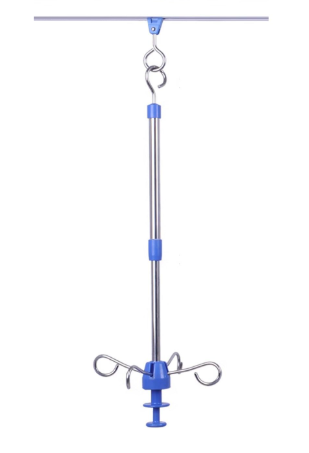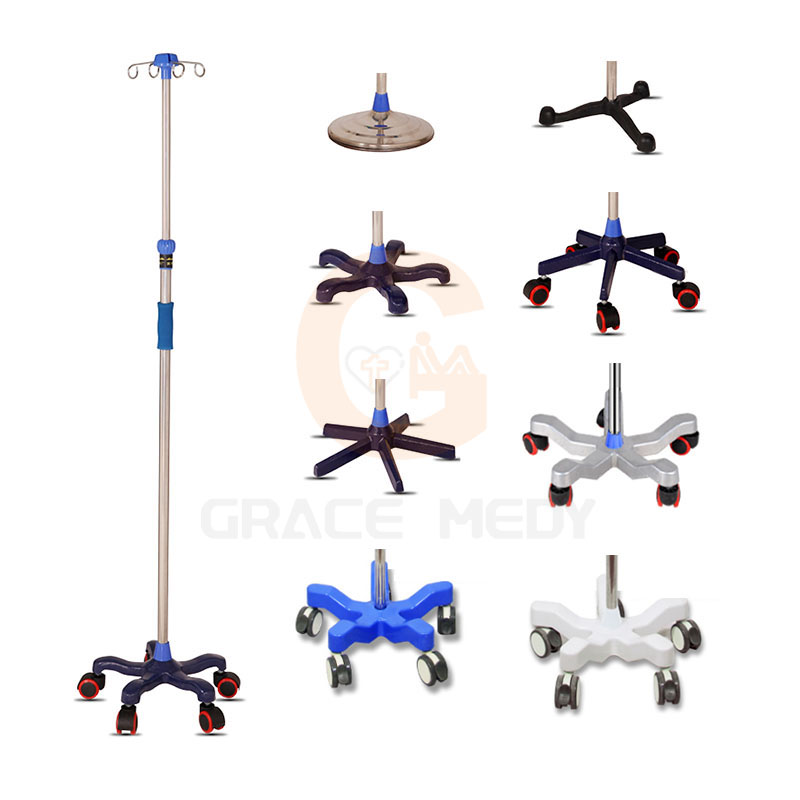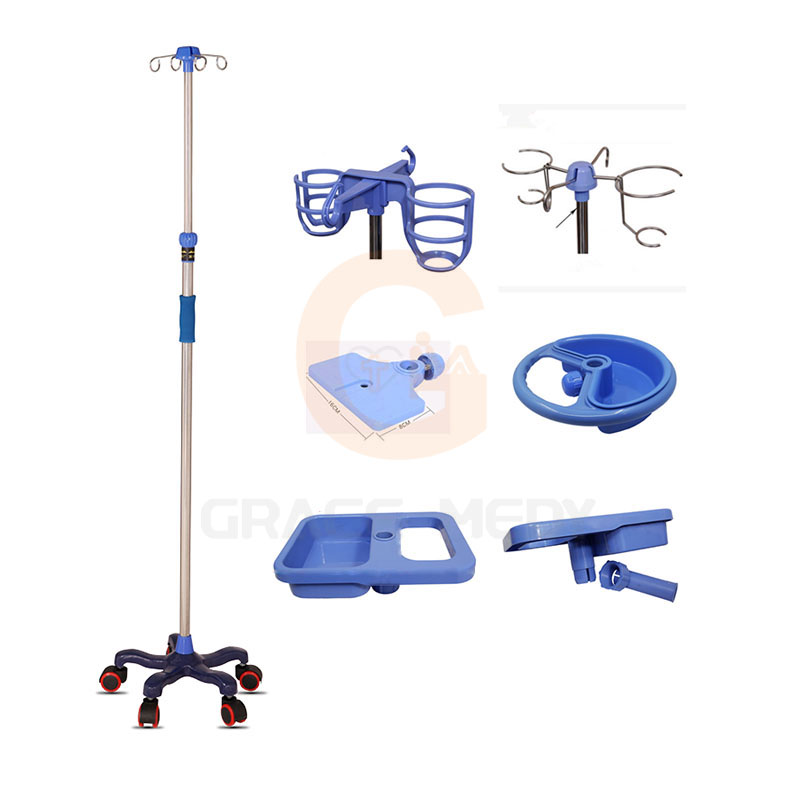Overview of IV Poles
In my experience, IV poles, which some people call intravenous poles or drip stands, are very important medical tools. We use them to help with intravenous therapy. I find these poles offer a safe, high spot for IV bags. This helps get fluids, medicines, or nutrients into a patient’s blood. Their main job is to help medical staff give ongoing and steady infusions to patients.

Main Uses of IV Poles
IV poles are very important in hospital bed. They help give intravenous (IV) treatments safely and correctly over time. I think their design is smart. It helps hang and send fluids, medicines, and blood products into a patient’s blood.
Common Applications of IV Poles
Giving Medications and Fluids:
I see IV poles holding bags or bottles. These deliver IV medicines, saline, dextrose, blood, and chemotherapy drugs. This way, patients get the correct treatment when they need it for different health issues.
Helping with Hydration:
From my experience, IV poles are often used for patients who need more fluids. This includes patients who are dehydrated, getting better after surgery, or are sick. IV poles help give these fluids in a controlled and secure way for as long as needed.
Giving Chemotherapy:
In cancer treatment areas, I believe IV poles are essential for giving anti-cancer drugs. They help control the drug flow. This control is important for good and safe chemotherapy treatments.
Help After Surgery:
I’ve seen that after surgery, patients usually need things like pain medicine, antibiotics, or nutrition. IV poles allow doctors and nurses to give these treatments without stopping. This helps patients get better quicker and can stop other problems from happening.
Care in Critical Situations and Emergencies:
In my opinion, in places like ICUs (intensive care units) and emergency rooms, IV poles are vital. They allow quick use of life-saving IV treatments. These can include medicines to support blood pressure, sedatives, or fluids to help someone right away.
Care for Children and Special Areas:
I know that some IV poles are made just for children. Others are designed for particular places, like operating rooms or clinics where patients walk in. These special designs help meet the unique needs of these different patient groups.
Benefits in All Healthcare Places
IV poles help give IV treatments safely, well, and without interruption.
Types of IV Poles
I think it’s key to know the different IV pole types. This helps you pick the right one for different healthcare places. You’ll find IV poles in many designs. These designs suit hospitals, clinics, and places that give special patient care.
Ceiling-Mounted IV Poles
Hospitals install ceiling-mounted infusion poles on ceiling tracks. I often see these in hospital wards. Wards need that flexibility. Staff can slide the pole anywhere along the track. I find this setup works well for patients. They might need IV therapy in different spots or positions in the ward.

Plug-In IV Poles
You can mount or attach plug-in IV poles to fixed surfaces. You’ll see them fixed to stretchers, carts, wheelchairs, or hospital beds. I like their stability. They keep IV fluids near the patient and use no floor space. I recommend plug-in poles for tight spaces. Think operating rooms, critical care units, or right at the bedside. Because they are fixed, they offer a steady IV supply. This is great when patients don’t move much.
Mobile or Rolling IV Poles
People really like mobile IV poles, or rolling IV poles as some call them. I find them easy to move around. They have wheels on the base. So, staff can easily push them from one room or department to another. I’ve noticed most mobile poles have four or five legs. The “5 Leg Spider” style is one example. This design gives them good stability and balance because of the added weight and support. This feature is why I find them so useful in busy hospital spots. You need to be flexible and move things quickly in those areas.

Key Features and Components of IV Poles
If you’re selecting or using IV poles in healthcare spots, I think it’s good to understand their main parts. Knowing how they all function helps make sure IV treatments are dependable.
Essential Components and Materials
Hooks for IV Bags:
IV poles often have several hooks on top. This lets you hang multiple IV fluid or medicine bags at the same time. I’ve seen some advanced IV poles that can hold up to 8 hooks. These are great for patients who need many infusions at once.
Pole Materials:
Manufacturers build most IV poles from stainless steel, chrome, or aluminum. I find stainless steel is very common. It’s tough and simple to clean. This is really important in hospitals and operating rooms. People pick aluminum because it’s lighter. This makes the poles easier to move. You might see chrome-plated steel sometimes. However, from my experience, it doesn’t fight off rust as well as stainless steel or aluminum. This can be a problem if you plan to use it for a long time.
Adjustable Height and Stability
Telescoping Adjustment:
I’ve noticed many IV poles have telescopic parts. These allow caregivers to change the height to suit the patient or the specific medical need. The usual height you can adjust them to is between 68 inches and 88 inches. Some stronger, heavy-duty poles can go higher than 90 inches. This offers more options for various medical settings.
Stable Base Design:
I believe the base is crucial for keeping the pole stable and easy to move. It can be made of cast iron, which gives steady support. Or it might be lightweight aluminum or steel. Most bases I’ve seen have 4, 5, or 6 legs. These legs usually have swivel wheels on the end. A typical base is about 25 3/4 inches across. This size helps spread the weight well. The weighted base is important because it stops the pole from tipping over. This is true even if it’s holding several or heavy IV bags.

Load Capacity and Portability
Supporting Medical Loads:
Standard IV poles can hold up to 50 lbs. This is when you center the weight near the pole. I know that some special models are made stronger. They can handle extra equipment like infusion pumps or oxygen tanks. This helps meet different clinical requirements.
Enhanced Mobility:
Bases with wheels make IV poles simple to move. You can easily take them around hospital rooms or to other care spots. I think portability is a big plus. It means patients can walk or someone can move them while they still get their IV treatment. This is good for the patient’s recovery and helps things run smoothly in the hospital.
Accessory and Safety Options
Accessory Attachments:
I’ve seen many IV poles with extra features. These can include attached baskets, holding rods, built-in power strips, and O2 tank holders. I find these additions useful. They help organize other medical gear and keep important items nearby.

Specialty Options:
Makers construct some IV poles from non-magnetic aluminum. I know this is a must-have in MRI rooms. It protects patients when they are having diagnostic scans.
I think these features and parts help IV poles handle the tough needs of today’s medical care. They support patient safety and also help clinics run well.
Where I See IV Poles Used Most Often
I find IV poles are very important in many healthcare places. They help give IV treatments safely and well. I often see them in these places:
Hospitals
I notice IV poles are a common sight in regular hospital rooms, after-surgery recovery spots, and special units.
They assist in giving ongoing IV fluids, medicines, and blood.
From my experience, hospitals use movable IV poles and ones fixed to the ceiling. This helps suit what different patients require.
Clinics
In clinics where patients don’t stay overnight, I see IV poles used for quick treatments. These can be for getting fluids, medicine drips, or chemo.
I believe IV poles on wheels are a good choice for clinics. They move easily from one treatment room to another.
Emergency Rooms
In emergency rooms, I think IV poles need to be strong and very mobile.
These poles help staff give fluids and medicines quickly. This is vital during urgent health problems.
Surgical Suites and Operating Rooms
For surgery areas, it’s my understanding that IV poles must be stable. They also need to be easy to clean.
I recommend models that plug in and attach to surgical beds or other gear. This helps keep the floor clear. It also lets staff get to them fast during surgery.
Intensive Care Units (ICUs)
In ICUs, I’ve observed they use special IV poles. These have many hooks and places to attach pumps, monitors, and medicine tubes.
It’s really important for these poles to be stable and hold a lot of weight.
Caring for People at Home
When people receive care at home, I suggest using IV poles that are light and easy to adjust. This helps patients move around more easily.
I’ve seen some models that are made to blend in at home. They have easy ways to adjust them, which is helpful for family members or home helpers who aren’t medical staff. For instance, turn the knob can adjustable the Iv pole height.
Get touch with IV POLE supplier
As a hospital furniture supplier, Grace Medy produces different types of IV stands and hospital beds for sale. We can also export batches of IV stands according to your needs.If you need, please submit the form to get our one-to-one consulting service.
Or contact us as follows:
Email: [email protected]
WhatsApp: 0086 19333723988
